Zijian Kang
LEREL: Lipschitz Continuity-Constrained Emotion Recognition Ensemble Learning For Electroencephalography
Apr 12, 2025Abstract:Accurate and efficient perception of emotional states in oneself and others is crucial, as emotion-related disorders are associated with severe psychosocial impairments. While electroencephalography (EEG) offers a powerful tool for emotion detection, current EEG-based emotion recognition (EER) methods face key limitations: insufficient model stability, limited accuracy in processing high-dimensional nonlinear EEG signals, and poor robustness against intra-subject variability and signal noise. To address these challenges, we propose LEREL (Lipschitz continuity-constrained Emotion Recognition Ensemble Learning), a novel framework that significantly enhances both the accuracy and robustness of emotion recognition performance. The LEREL framework employs Lipschitz continuity constraints to enhance model stability and generalization in EEG emotion recognition, reducing signal variability and noise susceptibility while maintaining strong performance on small-sample datasets. The ensemble learning strategy reduces single-model bias and variance through multi-classifier decision fusion, further optimizing overall performance. Experimental results on three public benchmark datasets (EAV, FACED and SEED) demonstrate LEREL's effectiveness, achieving average recognition accuracies of 76.43%, 83.00% and 89.22%, respectively.
Information Bottleneck-Guided Heterogeneous Graph Learning for Interpretable Neurodevelopmental Disorder Diagnosis
Feb 28, 2025Abstract:Developing interpretable models for diagnosing neurodevelopmental disorders (NDDs) is highly valuable yet challenging, primarily due to the complexity of encoding, decoding and integrating imaging and non-imaging data. Many existing machine learning models struggle to provide comprehensive interpretability, often failing to extract meaningful biomarkers from imaging data, such as functional magnetic resonance imaging (fMRI), or lacking mechanisms to explain the significance of non-imaging data. In this paper, we propose the Interpretable Information Bottleneck Heterogeneous Graph Neural Network (I2B-HGNN), a novel framework designed to learn from fine-grained local patterns to comprehensive global multi-modal interactions. This framework comprises two key modules. The first module, the Information Bottleneck Graph Transformer (IBGraphFormer) for local patterns, integrates global modeling with brain connectomic-constrained graph neural networks to identify biomarkers through information bottleneck-guided pooling. The second module, the Information Bottleneck Heterogeneous Graph Attention Network (IB-HGAN) for global multi-modal interactions, facilitates interpretable multi-modal fusion of imaging and non-imaging data using heterogeneous graph neural networks. The results of the experiments demonstrate that I2B-HGNN excels in diagnosing NDDs with high accuracy, providing interpretable biomarker identification and effective analysis of non-imaging data.
Scalable Vision Language Model Training via High Quality Data Curation
Jan 10, 2025



Abstract:In this paper, we introduce SAIL-VL (ScAlable Vision Language Model TraIning via High QuaLity Data Curation), an open-source vision language model (VLM) of state-of-the-art (SOTA) performance with 2B parameters. We introduce three key improvements that contribute to SAIL-VL's leading performance: (1) Scalable high-quality visual understanding data construction: We implement a visual understanding data construction pipeline, which enables hundred-million-scale high-quality recaption data annotation. Equipped with this pipeline, we curate SAIL-Caption, a large-scale caption dataset with large quantity and the highest data quality compared with opensource caption datasets. (2) Scalable Pretraining with High-Quality Visual Understanding Data: We scale SAIL-VL's pretraining budget up to 131B tokens and show that even a 2B VLM benefits from scaled up training data sizes, exhibiting expected data size scaling laws in visual understanding and instruction following performance. (3) Scalable SFT via quantity and quality scaling: We introduce general guidance for instruction data curation to scale up instruction data continuously, allowing us to construct a large SFT dataset with the highest quality. To further improve SAIL-VL's performance, we propose quality scaling, a multi-stage training recipe with curriculum learning, to improve model performance scaling curves w.r.t. data sizes from logarithmic to be near-linear. SAIL-VL obtains the highest average score in 19 commonly used benchmarks in our evaluation and achieves top1 performance among VLMs of comparable sizes on OpenCompass (https://rank.opencompass.org.cn/leaderboard-multimodal). We release our SAIL-VL-2B model at HuggingFace (https://huggingface.co/BytedanceDouyinContent/SAIL-VL-2B).
Neural-MCRL: Neural Multimodal Contrastive Representation Learning for EEG-based Visual Decoding
Dec 23, 2024



Abstract:Decoding neural visual representations from electroencephalogram (EEG)-based brain activity is crucial for advancing brain-machine interfaces (BMI) and has transformative potential for neural sensory rehabilitation. While multimodal contrastive representation learning (MCRL) has shown promise in neural decoding, existing methods often overlook semantic consistency and completeness within modalities and lack effective semantic alignment across modalities. This limits their ability to capture the complex representations of visual neural responses. We propose Neural-MCRL, a novel framework that achieves multimodal alignment through semantic bridging and cross-attention mechanisms, while ensuring completeness within modalities and consistency across modalities. Our framework also features the Neural Encoder with Spectral-Temporal Adaptation (NESTA), a EEG encoder that adaptively captures spectral patterns and learns subject-specific transformations. Experimental results demonstrate significant improvements in visual decoding accuracy and model generalization compared to state-of-the-art methods, advancing the field of EEG-based neural visual representation decoding in BMI. Codes will be available at: https://github.com/NZWANG/Neural-MCRL.
Toward Accurate Camera-based 3D Object Detection via Cascade Depth Estimation and Calibration
Feb 07, 2024Abstract:Recent camera-based 3D object detection is limited by the precision of transforming from image to 3D feature spaces, as well as the accuracy of object localization within the 3D space. This paper aims to address such a fundamental problem of camera-based 3D object detection: How to effectively learn depth information for accurate feature lifting and object localization. Different from previous methods which directly predict depth distributions by using a supervised estimation model, we propose a cascade framework consisting of two depth-aware learning paradigms. First, a depth estimation (DE) scheme leverages relative depth information to realize the effective feature lifting from 2D to 3D spaces. Furthermore, a depth calibration (DC) scheme introduces depth reconstruction to further adjust the 3D object localization perturbation along the depth axis. In practice, the DE is explicitly realized by using both the absolute and relative depth optimization loss to promote the precision of depth prediction, while the capability of DC is implicitly embedded into the detection Transformer through a depth denoising mechanism in the training phase. The entire model training is accomplished through an end-to-end manner. We propose a baseline detector and evaluate the effectiveness of our proposal with +2.2%/+2.7% NDS/mAP improvements on NuScenes benchmark, and gain a comparable performance with 55.9%/45.7% NDS/mAP. Furthermore, we conduct extensive experiments to demonstrate its generality based on various detectors with about +2% NDS improvements.
SupFusion: Supervised LiDAR-Camera Fusion for 3D Object Detection
Sep 13, 2023



Abstract:In this paper, we propose a novel training strategy called SupFusion, which provides an auxiliary feature level supervision for effective LiDAR-Camera fusion and significantly boosts detection performance. Our strategy involves a data enhancement method named Polar Sampling, which densifies sparse objects and trains an assistant model to generate high-quality features as the supervision. These features are then used to train the LiDAR-Camera fusion model, where the fusion feature is optimized to simulate the generated high-quality features. Furthermore, we propose a simple yet effective deep fusion module, which contiguously gains superior performance compared with previous fusion methods with SupFusion strategy. In such a manner, our proposal shares the following advantages. Firstly, SupFusion introduces auxiliary feature-level supervision which could boost LiDAR-Camera detection performance without introducing extra inference costs. Secondly, the proposed deep fusion could continuously improve the detector's abilities. Our proposed SupFusion and deep fusion module is plug-and-play, we make extensive experiments to demonstrate its effectiveness. Specifically, we gain around 2% 3D mAP improvements on KITTI benchmark based on multiple LiDAR-Camera 3D detectors.
Instance-Conditional Knowledge Distillation for Object Detection
Oct 25, 2021

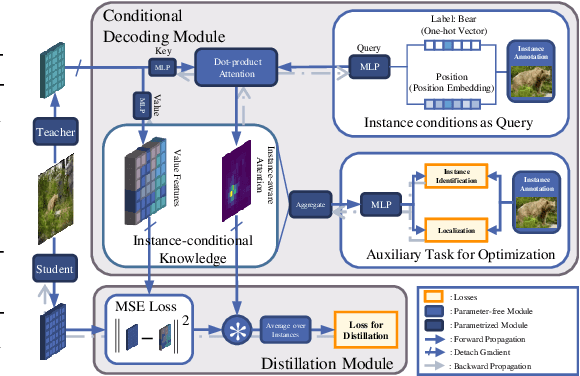
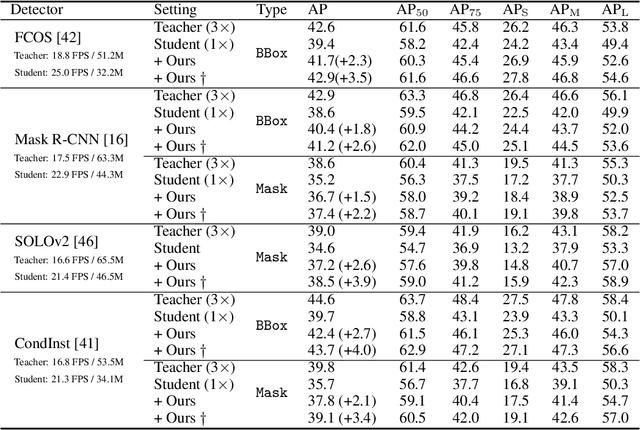
Abstract:Despite the success of Knowledge Distillation (KD) on image classification, it is still challenging to apply KD on object detection due to the difficulty in locating knowledge. In this paper, we propose an instance-conditional distillation framework to find desired knowledge. To locate knowledge of each instance, we use observed instances as condition information and formulate the retrieval process as an instance-conditional decoding process. Specifically, information of each instance that specifies a condition is encoded as query, and teacher's information is presented as key, we use the attention between query and key to measure the correlation, formulated by the transformer decoder. To guide this module, we further introduce an auxiliary task that directs to instance localization and identification, which are fundamental for detection. Extensive experiments demonstrate the efficacy of our method: we observe impressive improvements under various settings. Notably, we boost RetinaNet with ResNet-50 backbone from 37.4 to 40.7 mAP (+3.3) under 1x schedule, that even surpasses the teacher (40.4 mAP) with ResNet-101 backbone under 3x schedule. Code will be released soon.
LGD: Label-guided Self-distillation for Object Detection
Sep 23, 2021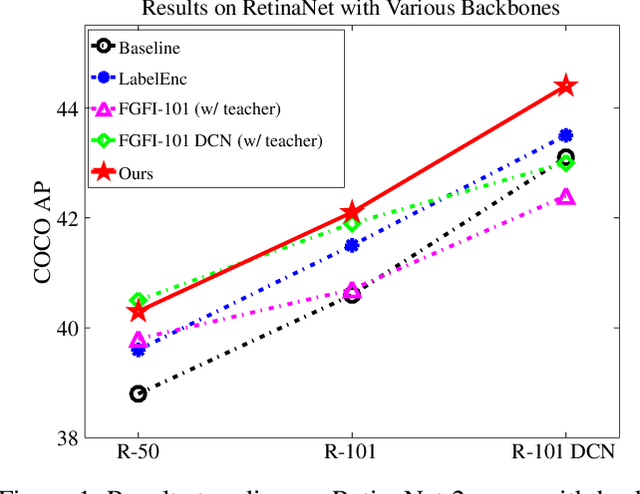
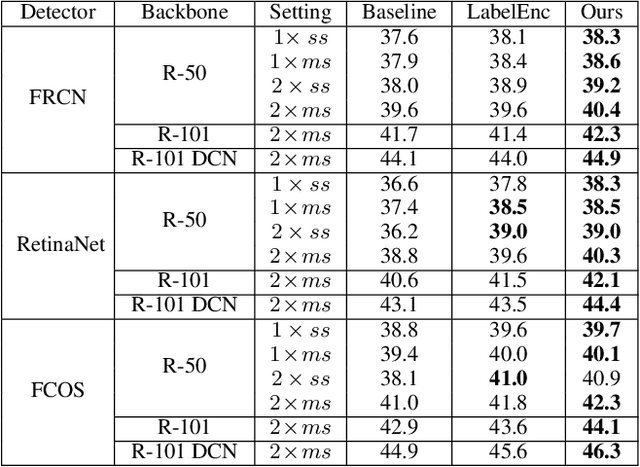

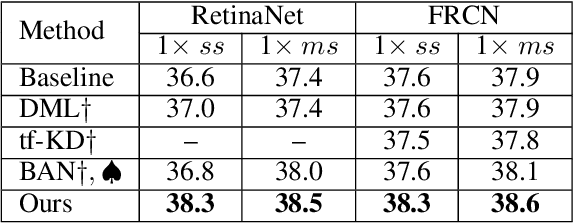
Abstract:In this paper, we propose the first self-distillation framework for general object detection, termed LGD (Label-Guided self-Distillation). Previous studies rely on a strong pretrained teacher to provide instructive knowledge for distillation. However, this could be unavailable in real-world scenarios. Instead, we generate an instructive knowledge by inter-and-intra relation modeling among objects, requiring only student representations and regular labels. In detail, our framework involves sparse label-appearance encoding, inter-object relation adaptation and intra-object knowledge mapping to obtain the instructive knowledge. Modules in LGD are trained end-to-end with student detector and are discarded in inference. Empirically, LGD obtains decent results on various detectors, datasets, and extensive task like instance segmentation. For example in MS-COCO dataset, LGD improves RetinaNet with ResNet-50 under 2x single-scale training from 36.2% to 39.0% mAP (+ 2.8%). For much stronger detectors like FCOS with ResNeXt-101 DCN v2 under 2x multi-scale training (46.1%), LGD achieves 47.9% (+ 1.8%). For pedestrian detection in CrowdHuman dataset, LGD boosts mMR by 2.3% for Faster R-CNN with ResNet-50. Compared with a classical teacher-based method FGFI, LGD not only performs better without requiring pretrained teacher but also with 51% lower training cost beyond inherent student learning.
 Add to Chrome
Add to Chrome Add to Firefox
Add to Firefox Add to Edge
Add to Edge